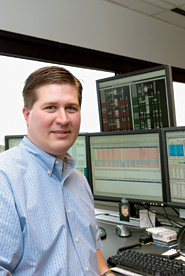For the small-cap trader, fragmentation remains a major nemesis, says Bridgeway Capital’s Dave Jennings, a 12-year trading veteran. This is especially true for him, since half of his trading is done in companies with market capitalizations ranging from $100 million to $2 billion.

"It’s much harder to get trades done now," Jennings said. "It wasn’t as hard when equities traded at a single exchange or venue."
And he would know, as a former trader on the floor of the Chicago Board Options Exchange; he remembers what it was like there to find the other side of a trade. And before that, he held a job in finance–a valuable commodity these days in trading.
Jennings recently celebrated his eighth year at Bridgeway. He recalled how he traveled to Chicago after graduating from Texas A&M in 1998 to pursue a career in finance.
He landed his first job in the spring of 1999 as a clerk at a small options market maker on the floor of the CBOE, after spending days knocking on doors and sleeping on friends’ couches. Jennings focused on doing whatever it took to land on a trading floor and learn the business. He later became a trader, which he relished.
Today, his preferred method of trading is taking a shot in the various institutional block-trading systems. When it works, great. However, he says, locating blocks in his names has gotten harder. More often, he sees much smaller trade sizes–100- to 200-share lots.
"You have to adapt to how the markets have changed," Jennings said. "It’s a matter of what the implementation goals are for the particular portfolio. Do you have the time to be very patient and wait for liquidity to come to you? Or do you have a need to get the order done right away?"

Privately held Bridgeway has 12 portfolios, and the desk likes to trade blocks of at least 25,000 shares when possible. But when it can’t, it uses alternative venues, such as dark pools. That said, while the unlit markets offer him additional liquidity, Jennings says he avoids certain dark pools due to predatory traders lurking there.
The desk executes up to 95 percent of its flow electronically–80 percent through either algos or direct market access, with the balance via crossing networks.
Just three years ago, the firm rarely used algorithms. Bridgeway now has 10 to 20 of these electronic beauties in its arsenal. Jennings says that while he only uses a handful of them regularly, algorithms account for almost 25 percent of the firm’s trading volume. Its daily trading volume is between 1.5 million to 2 million shares.
"Algos can certainly help add capacity to a desk," he said, pointing out that a trader needs to keep an eye on them, particularly in the small-cap space, because, "if they don’t perform well, then you’re not helping your desk’s performance."
(c) 2010 Traders Magazine and SourceMedia, Inc. All Rights Reserved.
http://www.tradersmagazine.com http://www.sourcemedia.com/





